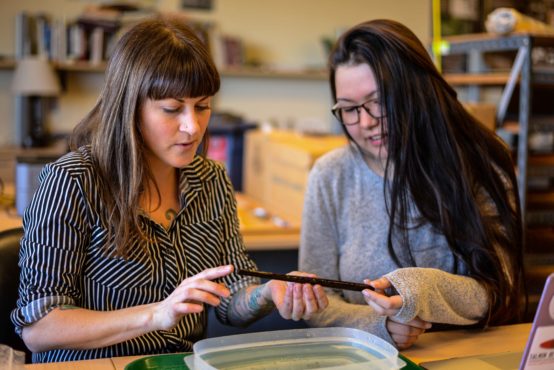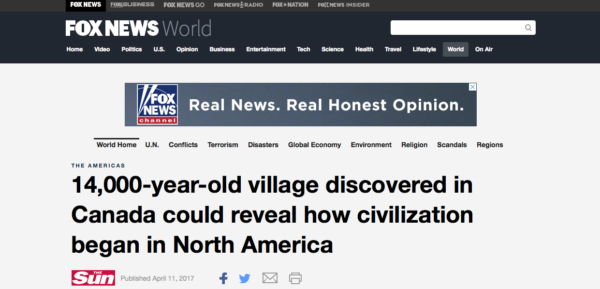The quiet concentration inside UVic’s archaeology research lab gives no indication of the media commotion that arrived alongside the discovery of 14 000-year-old artifacts on Triquet Island in Heiltsuk Territory last spring.
One of the research assistants, Larissa Dixon, is a second-year anthropology student at UVic and is of Heiltsuk descent. Her family can trace their ancestry back generations through its associated nuyems, or oral histories.
“The media took it in a whirlwind,” she said, speaking of the Triquet Island discovery last spring. Dixon had put down the stone artifacts she had been cataloguing “for future generations to learn from” and came to speak with me just outside the lab. “The sensationalized aspect of it all was just really overwhelming.”

Alisha Gauvreau and Larissa Dixon prepare to take measurements of a worked wood artifact from the Triquet Island village site. The measurements will be used in Dixon’s independent class paper which Gauvreau will later reference for her PhD thesis. Photo provided
The sheer age of the artifacts at the Triquet Island village site was enough to spur international media attention. The Vancouver Sun, CTV, and the CBC covered the story in Canada, and it was quickly picked up by the Independent and the Daily Mail in the United Kingdom and Fox News in the United States. The coverage extended to less mainstream news outlets as well, and was shared widely around the internet.
Alisha Gauvreau is the PhD student who has been helping spearhead the Triquet Island project for the last three years. Triquet Island is located near Bella Bella on B.C.’s Central Coast, and the archaeological findings that dated it as one of the oldest sites in North America represented a change in the common understanding of first human settlements of the region and the continent.
The media attention should have been exciting, but there was one problem — it was largely inaccurate.
The coverage last spring “was actually a little anxiety inducing,” Gauvreau said. “I feel responsible for any misreported information. It also changed my relationships with some people.”
“They kept making it this sexy headline of ‘Graduate student uncovers ancient site,’” she continued, explaining that this diminished the fact that this discovery was about the First Nation’s history of the area and not the glorification of western science.
“There’s people connected to this site,” Dixon said, referring to her Heiltsuk ancestors. “There’s people who created these artifacts, there’s people who lived here, resided here.”
An extensive Facebook post published by Gauvreau on April 7, 2017, detailed other weaknesses of the coverage, such as referring to Heiltsuk oral histories as myths or fables.
“I’ve gotta say that I’m not thrilled with CTV’s coverage,” the post read. “It’s as if they didn’t even read the CBC article, or listen to anything William [Housty] and I shared in our interviews.
“I thought the ‘pan-flute’ in the Vancouver Sun video was awful but this is even worse.”
“I kind of lashed out at CTV,” Gauvreau told me, “but a lot of the spin-off media outlets just kept repeating the same erroneous info.” Gauvreau said CTV later apologized to her and William Housty, who is a member of the Heiltsuk First Nation involved with the project. But although CTV updated its story, other media was not corrected.
“Alisha [Gauvreau] did do a pretty good job of trying to correct [it],” Dixon said. “She wanted to take the spotlight off of her and UVic and the Eurocentric side of it all and try to incorporate more of the cultural leaders and the people back home.”

The media storm around the Heiltsuk find extended worldwide.
The newest findings of the project — kept secret for now — will be published sometime in spring 2018, said Gauvreau. In preparation, the UVic and Hakai Institute research teams and the Heiltsuk Integrated Resource Management Department (HIRMD) are taking steps to ensure that if there is another media “whirlwind” it will represent the findings accurately and put the Heiltsuk Nation and their values in the limelight.
“Moving forward, we’ve got a plan for who will be involved immediately and what steps to take should media want to — and they do want to — cover more of the story as it develops,” Gauvreau said.
The HIRMD, which oversees the stewardship of cultural and natural resources within Heiltsuk Territory, is updating their current memorandum of understanding to streamline this process.
The new plan also involves preemptive measures. Gauvreau’s recent trip to Bella Bella in early October focused on giving presentations to HIRMD staff so that she could receive direct feedback and ensure her public outreach efforts were representing the community and their values accurately. The trip was funded by the Hakai Institute, a long-term coastal ecological research centre located on Calvert Island and Quadra Island. The Hakai Institute has funded and been involved with the research on Triquet Island from the get-go.
As part of the plan, a selected HIRMD representative with an in-depth understanding of Heiltsuk history will accompany Gauvreau when she presents relevant research publicly. These public presentations will be held at various venues and conferences in the coming months. The last one was held on Oct. 30 at the Mary Winspear Centre in Sidney, with Dixon serving as the community representative.
Now, in the lab, as ancient stone artifacts sit quietly in their Ziploc catalogues, the air of anticipation for the next media surge seems almost palpable.
Yet, Gauvreau says the foundation of solidarity that has been reinforced since last spring has her feeling confident.
“The reciprocal nature of our relationships in terms of developing these plans and protocols has been incredible,” said Gauvreau. “It’s actually a really nice model, I think, for other researchers wanting to work with communities.”
Thanks for reading! If you enjoyed this article and would like to make sure we keep writing articles like it, please consider supporting us on the Martlet 70 fundraiser’s GoFundMe page.
If you hated the article, though, you should still donate to the GoFundMe page (so we can hire better writers).








